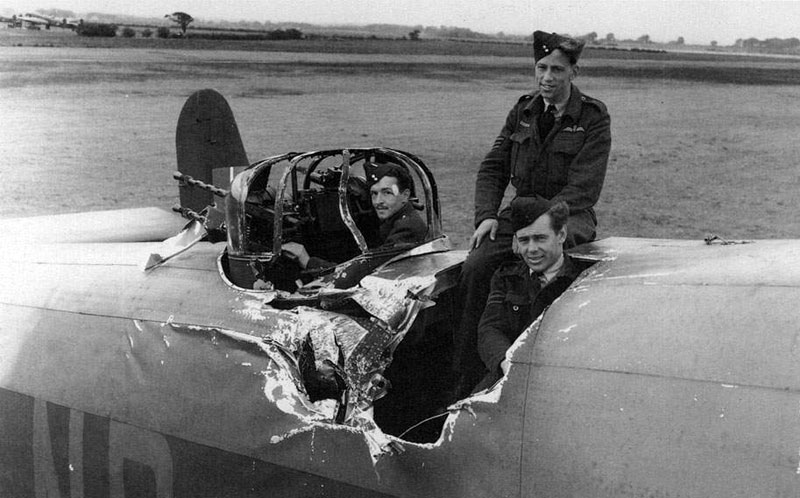Halifax HR837 damaged in air, returned to Lissett airfield.
The crew of this 158 Squadron aircraft took off from Lissett at 23.24hrs on 28th June 1943 to undertake an operational flight to bomb Cologne. The aircraft was attacked by an enemy aircraft on the approach to the target area and was slightly damaged, the pilot took evasive action and the night-fighter was lost. While over the target area at 02.05hrs and while flying at 20,000 feet this aircraft was flying below other bombers that were releasing their load. One 1,000lb bomb released by a higher flying aircraft struck the fuselage of HR837 just in front of the mid upper turret and passed right through the Halifax. The mid upper turret was damaged and despite the huge hole that was left in the aircraft the crew were able to bring it back to England. They landed at Lissett at 04.46hrs. The aircraft was repaired and went onto to serve with 1656 Heavy Conversion Unit until early 1945. The photo above is one of a number of photographs showing members of the crew standing in the hole in the fuselage.
Pilot - Sgt Douglas Charles Cameron RAFVR (1318221).
Navigator - Sgt John Frederick George Lane RAFVR (1388812).
Bomb Aimer - P/O George James Wallace RAFVR (129183).
Wireless Operator / Air Gunner - Sgt Robert Edward Hardwick RAFVR (1325790).
Flight Engineer - Sgt Harry Hulme RAFVR (952346).
Mid Upper Gunner - Sgt Alan Kenneth Young RAFVR (1320144).
Rear Gunner - F/Sgt George Burns James Young RAAF (413068).
Douglas Cameron received a commission on 30th June 1943 to the rank of P/O on probation (emergency). He was later awarded the DFC for service with 158 Squadron and the citation mentions this incident in June 1943, the DFC was Gazetted on 18th April 1944, the citation reads.. "This officer, who was awarded the Distinguished Flying Medal for gallantry on his first sortie, has completed a large number of sorties, involving attacks on heavily defended targets in Germany. He has displayed a high degree of skill and courage and throughout his determination to inflict loss on the enemy has been most commendable. On one occasion, early in his operational career, Flying Officer Cameron's aircraft sustained severe damage whilst over the target area. Half the mid-upper turret was ripped away, whilst a hole some 5 feet in diameter was torn in the fuselage. In spite of this, Flying Officer Cameron flew the damaged aircraft home. On several other occasions, Flying Officer Cameron has proved his skill by flying his damaged aircraft to base. He is a model captain and his achievements have been outstanding." He survived the War having risen through F/O to F/Lt two years after his commission date.
Alan Young received a commission on 30th June 1943. He remained in the RAF at least until 1953.

The pilot and two air gunners were awarded the DFM for their actions in June 1943 on their first operational flight with 158 Squadron which saw the aircraft damaged by flak, four of the crew then baled out, Cameron and both air gunners stayed in the aircraft and found their way to land at Downham Market. Gazetted on 13th July 1943 their joint citation reads.."captain, mid-upper and rear gunners respectively of an aircraft which attacked Mulheim. Shortly after bombing the target, the aircraft was illuminated by searchlights and subjected to heavy anti-aircraft fire. The bomber was repeatedly hit and sustained damage. Sergeant Young, the rear gunner, received facial injuries and, temporarily lost consciousness. He was given first aid by the mid-upper gunner and, on recovery, he coolly beat out the flames from some burning equipment with his gloves. Meanwhile, Sergeant Cameron skilfully evaded the defences and, displaying great determination, flew the damaged bomber to an airfield in this country. On this, their first operational flight, these airmen displayed courage and resource of a high order."
John Lane received a commission on 4th September 1943. He was later awarded the DFC for service with 158 Squadron, Gazetted on 6th June 1944
Harry Hulme received a commission on 11th March 1944. He was awarded the DFM for service prior to his commission, Gazetted on 18th April 1944 the citation reads.."As flight engineer, Sergeant Hulme has completed a tour of operations on which most of the enemy's well defended targets have been attacked. Throughout he has displayed a high standard of technical ability which has contributed materially to the very many successes his captain has achieved. Sergeant Hulme is a most valuable member of aircraft, whose exemplary conduct at all times has been highly commendable.
F/Sgt Robert Hardwick was killed with 158 Squadron on 25th May 1944 and is buried in Rheinberg War Cemetery.
Halifax HR837 was built to contract ACFT/1688/42 by Handley Page Ltd, at Radlett and was flown to 8 M.U. at Little Rissington on 9th May 1943. The aircraft was taken on charge by 158 Squadron at Lissett on 20th May 1943. As a result of sustaining battle damage on 28th May 1943 Cat.A/FB damage was the assessment and it was repaired on site. On 29th June 1943 it sustained freak damage on Ops to Cologne when a 1,000 lb bomb passed through the fuselage near the mid upper turret, despite the damage the crew flew the damaged aircraft back to the UK. Cat.B/FB damage was the damage assessment and a repair on site was carried out by Handley Page Ltd; it was fitted with a replacement rear fuselage section. The aircraft was returned to 158 Squadron charge on 17th January 1944. On 12th April 1944 it was transferred to 1656 Heavy Conversion Unit at Lindholme. On 12th July 1944 it sustained Cat.Ac/FA damage at Lindholme in a collision with Halifax JD307, a repair on site was carried out and it was returned to 1656 H.C.U. on 1st August 1944. On 1st January 1945 the aircraft was flown to 48 M.U. at Hawarden for disposal and was struck off charge days later on 11th January 1945.